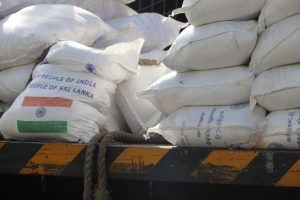Sri Lanka’s economic crisis has resulted in grave political and socio-economic consequences for the island nation’s residents. But beyond its effects on national stability, this crisis also has significant implications for the India-China power competition in South Asia.
The unfolding situation may impede China’s intent to increase its regional strategic influence and power projection. Alternatively, this situation can serve as an opportunity for India, which had warily watched China’s growing influence in the region in the last few years. New Delhi now has a unique opportunity to strengthen its leadership role and showcase its positive contribution to South Asian stability by addressing and sorting out the mess underwritten by Beijing’s investments.
China’s rise in the last decade has been coupled with a desire to project power and maximize its influence beyond its immediate neighborhood. Since the mid-2000s, China has steadily expanded its far seas operations toward the Indian Ocean to increase its strategic footprints. It did so by participating in the anti-piracy operations in the Horn of Africa, extensively deploying its nuclear submarines across the Indian Ocean and establishing its first overseas base in Djibouti in 2017. Its impressive military capacity notwithstanding, China’s ability to sustain a robust military presence in the Indian Ocean Region and South Asia, in particular, is still constrained.
Among the most critical indicators of the strategic influence of an extra-regional power lies in its ability to sustain bilateral military exercises and operationalize defense cooperation with regional states.
While China has emerged as a major arms exporter to the region (primarily Pakistan, Bangladesh and Myanmar), it has not been able to expand military exchanges and other facets of defense cooperation with South Asian states. Moreover, given the geographic proximity with India and its growing material capabilities, South Asian states too (with the sole exception of Pakistan) have found it prudent to not overtly engage in actions with extra-regional states that may directly upset the regional balance of power. Therefore, China’s attempts to convert its growing presence into strategic influence to offset India’s leadership role in the region received a setback.
In attempting to build its image as a major development and economic partner in the region, China began engaging with various South Asian countries through its Belt and Road Initiative (BRI). In South Asia, Sri Lanka received billions of dollars worth of Chinese investments. Beijing provided sizeable loans that enabled Chinese companies to take up several key infrastructure projects in Sri Lanka, from road and port development to railway equipment supply. These Chinese projects were marred with controversy from the start given their lack of transparency, sustainability, and accountability. Yet, in the context of its affinity to Beijing, the influential Rajapaksa family, which facilitated these investments, turned a blind eye.
However, as the economic crisis unfolded this year, Sri Lanka’s indebtedness to China became clear. Some estimated that China accounted for 10 percent of Sri Lanka’s total debt, while others argued that 10 percent was an understatement and could be as large as 20 percent. Despite this, China remained reluctant to restructure Sri Lanka’s loans in the face of Colombo’s repeated requests.
This situation is a major challenge for China’s long-time efforts to cultivate the image of a responsible power, given its desire to incorporate as many states as possible into its BRI. On the contrary, the Sri Lanka crisis has shown that Beijing is not only an insufficient provider of economic growth and development but, with its hesitant response, also an unreliable comrade in case of economic distress.
This serves as a wake-up call for other countries, given that two other major recipients of Chinese loans in the region, Pakistan and Nepal, also seem to be treading a similar path. Pakistan faces heavy debts, many of which are large Chinese loans and investments, and this indebtedness is worsening. This coincides with Pakistan’s dwindling foreign exchange reserves when the cost of energy imports is rising. Likewise, Nepal is facing economically tough times with its foreign exchange reserves falling while the growing imbalance in its balance of payments deepens the liquidity crunch.
Conversely, the Sri Lanka crisis has allowed India to step in. New Delhi has emerged as a principal actor in resuscitating Colombo from an economic collapse. Since January 2022, it has offered unprecedented economic assistance worth $3.8 billion (for comparison, India invested $3 billion in Afghanistan between 2001-2021) to Colombo and plans to offer more once the situation stabilizes. India’s proactive actions to come to its neighbor’s aid have created a more positive perception of India in the region and beyond.
With back-to-back economic crises induced by Chinese investments, questions are now being raised on the effectiveness of China’s role as a development partner in the region. Moreover, the growing global pushback to Chinese investments and continuing skepticism over its economic growth add to these dynamics, putting India in an advantageous position.
Therefore, India has the potential to offset China’s growing but still limited influence in the region (barring perhaps Pakistan) by not only illustrating the gaps in China’s approach but, through economic assistance, also highlighting India’s approach as a better, people-centric and a viable alternative.

































